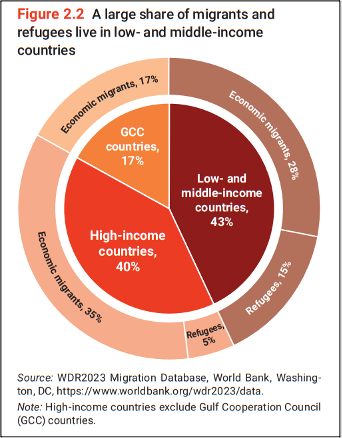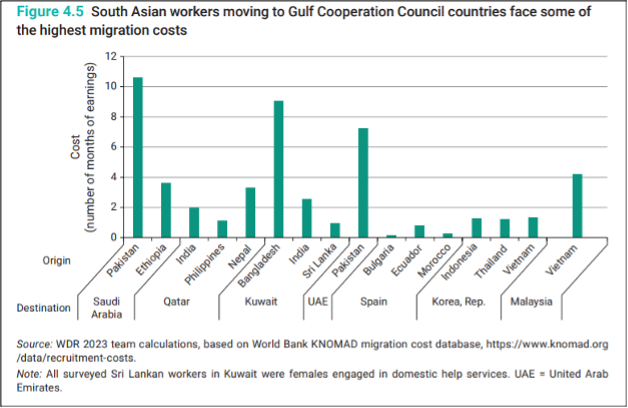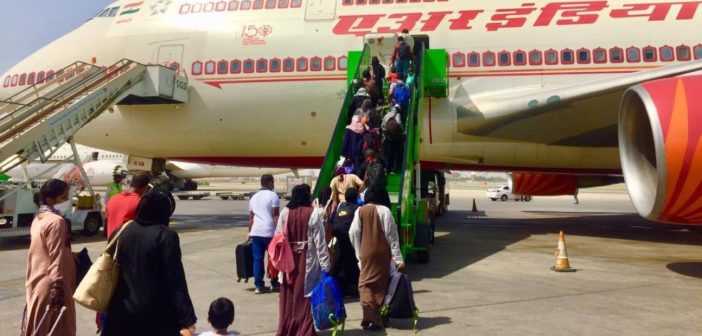The World Development Report is an annual flagship publication of the World Bank which provides an in-depth comprehensive assessment of a topic related to global development issues. The latest report for 2023 titled, “Migrants, Refugees, and Societies” was published recently. Here is a review of the important issues discussed in the report.
The World Development Report is an annual flagship publication of the World Bank which provides an in-depth comprehensive assessment of a topic related to global development issues. The first edition was published in 1978. Some of the topics covered in the previous reports are data, law and governance, labour, conflicts, gender, health, poverty, environment, climate change, risk management, agriculture, equity, health, and public finance. The latest report for 2023 titled, “Migrants, Refugees, and Societies” was published recently. The report provides an analysis of international migration and its potential to serve as a force for growth and shared prosperity in all countries. We review the important parts of this report in today’s story.
The report notes that migration has been recorded even in the earliest days of civilization, about 2 lakh years ago. Since then, human beings never ceased to move. This movement has been due to a plethora of reasons like seeking better economic opportunities, better education, displacement due to conflicts or natural disasters, among others. With millions of people leaving their country, migration is a development challenge. Migration is also considered a response to global imbalances, such as large welfare differences, and to shocks such as conflict and violence.
Cross-border migration has been covered in the report
In the World Bank Report, migrants have been defined as “people who live outside their country of nationality—whether they moved in search of better economic opportunities or were displaced by conflict or persecution (refugees).” In simpler terms, the report takes into consideration cross-border migration only. Those people who have been naturalized in their country of residence have not been included in this definition. The lack of citizenship for migrants deprives them of the civil, political, and economic rights the citizens enjoy.
The report has also identified 4 types of cross-border movements. These are-
- Economic migrants with strong skill match or those with skills in demand at the destination like Indian software engineers working in the USA
- Refugees with strong skill match or refugees who possess skills which are of demand at the destination like Syrian entrepreneurs in Turkey
- Refugees with a weak match or refugees who may have entered the country seeking immediate safety and do not possess the skills for labour at the destination like Rohingya in Bangladesh
- Distressed migrants or those migrants who are neither refugees nor have a strong skill match like poorly skilled migrants at the US southern border
Majority of the migrants live in low- and middle- income countries
As per the report, there are 184 million people who live outside their country including 37 million refugees. Migrants, as per the definition above, account for about 2.3% of the world’s population.
About 40% (64 million economic migrants and 10 million refugees) are in high-income OECD countries. These are mostly high and low-skilled workers and their families with the intent to settle in the destination country, temporary migrants, students, and undocumented migrants and persons seeking international protection. GCC countries host about 17% of them (31 million migrants) and almost all are temporary workers with renewable work visas. The remaining 43% (52 million economic migrants and 27 million refugees) live in low- and middle-income countries and the movement is primarily for jobs or family reunification or to seek international protection.

Share of immigrants in population is high in GCC Countries
The share of immigrants in the population of destination country is among the largest in GCC Countries and is the highest in UAE with 88%. That is, 88% of the population in the UAE is comprised of immigrants. In many high-income OECD countries, the share is about 5 to 15%. Ten countries namely Russia, Pakistan, Bangladesh, Turkey, Poland, Germany, Sudan, Uganda, Colombia, and Peru host more than half of all the refugees. Seeking safety and security, the refugees generally tend to move to neighbouring countries.
Cross-border migration has resulted in substantial increase in income
Migration has helped in reducing poverty in low-income & middle-income countries. This is because migrants, especially with strong skill match, tend to earn higher income in the destination countries than in their countries. For instance, Indians are estimated to earn nearly 120% more abroad in contrast to 40% increase for internal migrants. While Indians working as low-skilled workers in the GCC have a 118% increase in income, the same for Indians in UAE is nearly 300%. However, cross-border migration comes with a cost. In the case of low-skilled South Asian workers moving to some GCC countries, the cost to emigrate can be as high as 10 months of expected earnings. For Indians moving to Qatar or Kuwait, the migration cost is about two months of expected earnings.

Rapid demographic transitions and climate change have been cited as two drivers forcing cross-border movements. In high-income countries as well as many middle-income countries, the populations are aging because of which the labour supply and demand has been affected in these countries. Migration is an integral solution to help reduce the disparity in supply and demand. With respect to climate change, though most movements have been within the countries so far, it has the potential to increase in distressed international migration.
India received the highest remittances in 2021
The benefits from migration for the origin countries include remittances, knowledge transfers, and positive impacts on the labour market. Remittances help improve the income of the country, consumption, and allows increased households’ spending on health and education. India is the biggest recipient of remittances in 2021 with $ 89.38 billion and World Bank had estimated that India would cross the $100 billion milestone in 2022.
‘Match – motive’ Framework has been recommended to help policy formulation
Noting the importance of migration and the challenges arising out of it, the World Bank report has enlisted some recommendations.
A Match – Motive Framework that focuses on two factors- how closely migrants’ skills and attributes match the needs of destination countries and what motives underlie their movements has been proposed. With this approach, policy makers will be able to identify priority areas, differentiate among the different types of movements and design migration policies for each of these movements.
Further, it also called for origin countries to make migration a part of their development strategy and for destination countries to use “strong match” migration to meet their labour needs. Destination countries were recommended to facilitate the inclusion of migrants and address social impacts that raise concerns among their citizens.
It also urges to use bilateral cooperation to strengthen the match of migrants’ skills and attributes with the needs of destination economies. Other recommendations include organizing regional and global responses to address refugee movements and reduce the need for distressed movements. It called for developing new and predictable financing instruments.
The World Bank’s World Development Report contributes to thinking about development from multiple angles. However, the current report has not delved deep into the impact of the COVID-19 pandemic on economic opportunities, and the changes that have emerged along with it like the option for remote work offered in certain sectors, where feasible.



